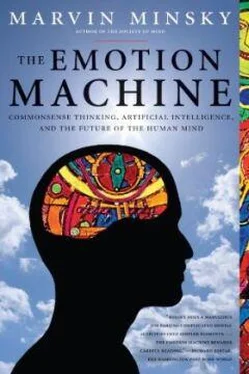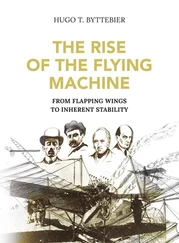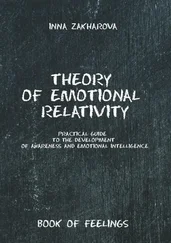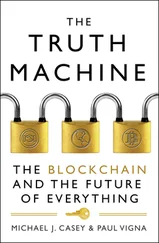
Of course, you first may need to make a plan for how to accomplish all those tasks —and making such plans can sometimes engage substantial parts of the rest of your mind.
Citizen: Why do you focus so much on goals, as though all we do is purposeful? Sometimes we simply react to what happens, or act out old, habitual scripts—and sometimes we daydream and fantasize, or aimlessly imagine things.
It would be very hard to prove that anything that a person does is wholly devoid of purposes—because, as Sigmund Freud observed, some of our mental processes may work to conceal from us some of our principal motives and goals. But in any case we need more ideas about how we form those purposes.
The most usual theory of how people learn is by what we call ‘trial and error.’ That’s how Carol learned when playing alone, when she worked by herself to fill her cup. She was annoyed when she failed with a fork, but was pleased by success when she used a spoon—so the next time she wants to fill a cup, she’ll be more likely to know what to do. That seems like simple common sense—that we learn from failure and from success—but we need a theory of how that might work.
Student: I suppose that her brain formed connections from her goal to the actions that helped her to achieve it.
OK, but that is rather vague. Could you say more about how that actually works?
Student: Perhaps Carol starts with some goals just floating around—but when she succeeds by using her spoon, then she somehow connects her “Fill Cup” goal to her “Use Spoon” goal. Also, when she fails with the fork, she makes a “don’t” connection to “Use Fork,” to keep from doing that again. Then, the next time she wants to fill a cup, she’ll first try the sub-goal of using a spoon.


That would be a good way to start, and I like your mentioning those “don’t” connections. These are important because we must not only learn to do things that work, but also must learn ways to avoid the most common mistakes.
However, while this kind of theory can help to explain how we interconnect goals that we already possess, it does not answer such questions as, “How do we get new goals that are not subgoals of existing ones?” or, more generally, “How do we learn new ideals and values?”
I don’t recall much discussion of in academic psychology books. The following sections will argue that we cannot acquire our high-level values in the same way that we learn other things, that is, by ‘learning from experience.’ Instead, we’ll argue that children learn values in special ways that depend on the persons to whom they are ‘attached.’
∞∞∞∞∞∞∞∞∞∞∞∞∞∞∞∞∞∞∞
“Now since shame is a mental picture of disgrace, in which we shrink from the disgrace itself and not from its consequences, and we only care what opinion is held of us because of the people who form that opinion, it follows that the people before whom we feel shame are those whose opinion of us matters to us. Such persons are: those who admire us, those whom we admire, those by whom we wish to be admired, those with whom we are competing, and whose opinion of us we respect.”
Aristotle, in
Rhetoric 2, 6
[12] http://etext.library.adelaide.edu.au/a/a8rh/
Our language has a great many words for describing our emotional states. When we described Carol’s playing with mud, we had to use over a dozen of them— affection, alarm, anxiety, assurance, disappointment, disgrace, disturbance, frustration, fear, inclination, pleasure, pride, satisfaction, shame, and sorrow .
Why do we have such states at all—and why do we have so many of them? Why does Carol feel grateful and proud when she receives praise from her mother? And how does this, somehow, ‘elevate’ goals to make them seem more desirable?
Student: You’ve already started to argue that she must have some kind of “attachment bond” that makes her react in that special way—just as Aristotle said, from concern with her mother’s regard for her. But this doesn’t explain why praise alone cannot elevate goals, but also depends on the presence of—umm, I can’t think of the proper word for this—“a person to whom one has become attached?”
Psychologists often use ‘caregiver’ for “a person to whom a child is attached.” They cannot say ‘parent’, or ‘mother’ or ‘father’ because someone else might play that role—like a grandparent, nurse, or family friend. But ‘caregiver’ is not the proper word because (as we’ll see in §2-7) such attachments can form without physical care. In any case, it seems quite strange that our language has no special word for this most influential relationship! So here I’ll introduce two new terms; both are based on an old word, ‘imprinting’, which long has been used by psychologists to refer to the processes in which young animals learn to keep close to their parents.
Imprimer: An Imprimer is one of those persons to whom a child has become attached.
Impriming: A special way to learn new values that works only when an Imprimer is present.
Of course, staying close to parents helps to keep offspring safe but, in humans it seems to have other effects; when we’re close to the persons to whom we’re attached—the ones that we shall call our ‘Imprimers’—we find ourselves thinking in special ways. Carol’s concern with her cupful of mud may have started out as a casual urge to play with materials near at hand—as just an engaging activity. But when she gets praise from one of her Imprimers, she feels a special thrill of pride that elevates her present goal to a higher kind of priority—and in future times she’ll find that, to her, this goal has become more “respectable.”
We’re always setting new goals for ourselves, but we often end up abandoning them. Why is it sometimes so hard for us to keep working toward what we’ve decided to do? In §9-2 we’ll come back to discuss self-discipline and self-control, but here we’ll only mention that attachments also can help us persist—either from hope that we’ll please our imprimers or from fear of disappointing them.
Why does an Imprimer’s praise have an effect so different from that of praise that comes from a stranger? I do not know of any brain-research that has revealed the machinery involved with this—but it is easy to see how it could have evolved: if strangers could change your high-level goals, they could get you to do whatever they want— just by changing what you, yourself, want to do! Children with no defense against this would be less likely to survive, so evolution would tend to select children who could resist that effect.
Student: I like the idea that Attachment induces our children to adopt our values (though perhaps you’ve induced me to agree by exploiting your role as Imprimer). But is there any evidence that this mechanism really exists?
So far as I know, no parts of our brains have yet been shown to be involved with this, but §2-7 discusses some evidence that damage to a child’s attachments can impair that child’s development. Future advances in ways to scan brains should tell us more about how such things work.
Читать дальше















